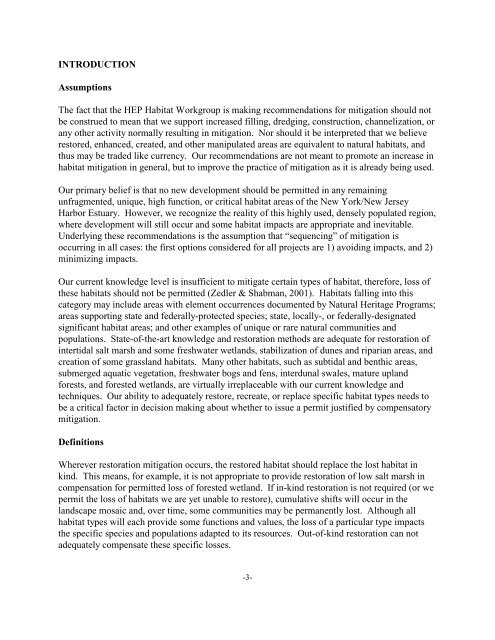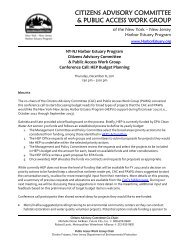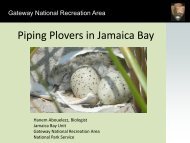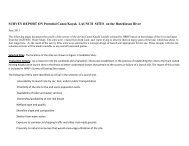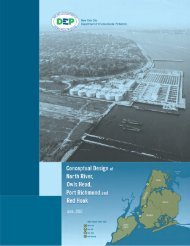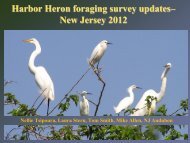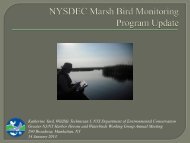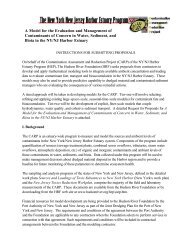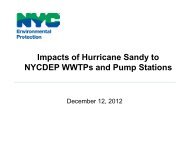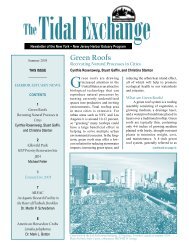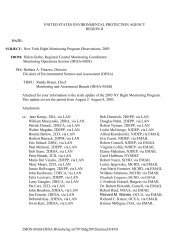DraftMitigation .pdf - New York-New Jersey Harbor Estuary Program
DraftMitigation .pdf - New York-New Jersey Harbor Estuary Program
DraftMitigation .pdf - New York-New Jersey Harbor Estuary Program
Create successful ePaper yourself
Turn your PDF publications into a flip-book with our unique Google optimized e-Paper software.
INTRODUCTION<br />
Assumptions<br />
The fact that the HEP Habitat Workgroup is making recommendations for mitigation should not<br />
be construed to mean that we support increased filling, dredging, construction, channelization, or<br />
any other activity normally resulting in mitigation. Nor should it be interpreted that we believe<br />
restored, enhanced, created, and other manipulated areas are equivalent to natural habitats, and<br />
thus may be traded like currency. Our recommendations are not meant to promote an increase in<br />
habitat mitigation in general, but to improve the practice of mitigation as it is already being used.<br />
Our primary belief is that no new development should be permitted in any remaining<br />
unfragmented, unique, high function, or critical habitat areas of the <strong>New</strong> <strong>York</strong>/<strong>New</strong> <strong>Jersey</strong><br />
<strong>Harbor</strong> <strong>Estuary</strong>. However, we recognize the reality of this highly used, densely populated region,<br />
where development will still occur and some habitat impacts are appropriate and inevitable.<br />
Underlying these recommendations is the assumption that “sequencing” of mitigation is<br />
occurring in all cases: the first options considered for all projects are 1) avoiding impacts, and 2)<br />
minimizing impacts.<br />
Our current knowledge level is insufficient to mitigate certain types of habitat, therefore, loss of<br />
these habitats should not be permitted (Zedler & Shabman, 2001). Habitats falling into this<br />
category may include areas with element occurrences documented by Natural Heritage <strong>Program</strong>s;<br />
areas supporting state and federally-protected species; state, locally-, or federally-designated<br />
significant habitat areas; and other examples of unique or rare natural communities and<br />
populations. State-of-the-art knowledge and restoration methods are adequate for restoration of<br />
intertidal salt marsh and some freshwater wetlands, stabilization of dunes and riparian areas, and<br />
creation of some grassland habitats. Many other habitats, such as subtidal and benthic areas,<br />
submerged aquatic vegetation, freshwater bogs and fens, interdunal swales, mature upland<br />
forests, and forested wetlands, are virtually irreplaceable with our current knowledge and<br />
techniques. Our ability to adequately restore, recreate, or replace specific habitat types needs to<br />
be a critical factor in decision making about whether to issue a permit justified by compensatory<br />
mitigation.<br />
Definitions<br />
Wherever restoration mitigation occurs, the restored habitat should replace the lost habitat in<br />
kind. This means, for example, it is not appropriate to provide restoration of low salt marsh in<br />
compensation for permitted loss of forested wetland. If in-kind restoration is not required (or we<br />
permit the loss of habitats we are yet unable to restore), cumulative shifts will occur in the<br />
landscape mosaic and, over time, some communities may be permanently lost. Although all<br />
habitat types will each provide some functions and values, the loss of a particular type impacts<br />
the specific species and populations adapted to its resources. Out-of-kind restoration can not<br />
adequately compensate these specific losses.<br />
-3-


